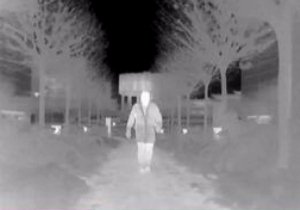
It seems to appear that these days, there is less need to justify the requirement of security cameras. Individuals and organizations that have the best overall security systems installed in their homes and offices have security cameras installed as part of these systems. It is one thing being aware of a security system in place and a completely different feeling of security when you can see the action through a security camera. However, one shouldn’t be satisfied with just any security camera being installed inside their homes and offices. Today, a night vision surveillance camera or an outdoor dome camera is just as important.
A night vision surveillance camera can be of many types but its primary function is to capture videos outside your home or office even at night.
During the daytime such a camera functions like a standard high definition camera but it comes into its own at night and offers additional coverage and surveillance.
Night vision as a concept is not new and the first nighttime pictures were captured back in 1871. Today, a night vision surveillance camera uses an image intensifier to capture images in low light and in some cases, no light.
Even when the light is minimum the lens can focus the photons (light in this case) on the photocathode of the image intensifier. This releases the electrons from the cathode. The electrons are accelerated by an electric field and their speed is increased.
Night vision technologies can be broadly divided into three main categories: image intensification, active illumination and thermal imaging.
Image intensification:
This magnifies the amount of received photons from various natural sources such as starlight or moonlight. Examples of such technologies include night glasses and low light cameras.
The image intensifier is a vacuum-tube based device that converts invisible light from an image to visible light so that a dimly lit scene can be viewed by a camera or the naked eye. While many believe the light is “amplified,” it is not. When light strikes a charged photocathode plate, electrons are emitted through a vacuum tube that strike the microchannel plate that cause the image screen to illuminate with a picture in the same pattern as the light that strikes the photocathode, and is on a frequency that the human eye can see. This is much like a CRT television, but instead of color guns the photocathode does the emitting.
The image is said to become “intensified” because the output visible light is brighter than the incoming IR light, and this effect directly relates to the difference in passive and active night vision goggles. Currently, the most popular image intensifier is the drop-in ANVIS module, though many other models and sizes are available at the market.
Active illumination:
Active illumination couples imaging intensification technology with an active source of illumination in the near infrared (NIR) or shortwave infrared (SWIR) band. Examples of such technologies include low light cameras.
Active infrared night-vision combines infrared illumination of spectral range 700–1,000 nm (just below the visible spectrum of the human eye) with CCD cameras sensitive to this light. The resulting scene, which is apparently dark to a human observer, appears as a monochrome image on a normal display device.[6] Because active infrared night-vision systems can incorporate illuminators that produce high levels of infrared light, the resulting images are typically higher resolution than other night-vision technologies.[7][8] Active infrared night vision is now commonly found in commercial, residential and government security applications, where it enables effective night time imaging under low-light conditions. However, since active infrared light can be detected by night-vision goggles, there can be a risk of giving away position in tactical military operations.
Laser range gated imaging is another form of active night vision which utilizes a high powered pulsed light source for illumination and imaging. Range gating is a technique which controls the laser pulses in conjunction with the shutter speed of the camera’s detectors.[9] Gated imaging technology can be divided into single shot, where the detector captures the image from a single light pulse, and multi-shot, where the detector integrates the light pulses from multiple shots to form an image. One of the key advantages of this technique is the ability to perform target recognition rather than mere detection, as is the case with thermal imaging.
Thermal vision:
Thermal imaging detects the temperature difference between the background and the foreground objects. Some organisms are able to sense a crude thermal image by means of special organs that function as bolometers. This allows thermal infrared sensing in snakes, which functions by detection of thermal radiation.
Thermal imaging cameras are excellent tools for night vision. They detect thermal radiation and do not need a source of illumination. They produce an image in the darkest of nights and can see through light fog, rain and smoke. Thermal imaging cameras make small temperature differences visible. Thermal imaging cameras are widely used to complement new or existing security networks, and for night vision on aircraft, where they are commonly referred to as “FLIR” (for “forward-looking infrared”.)
[…]
Source www.articlesolve.com

